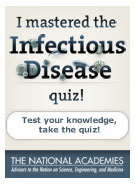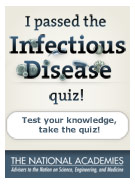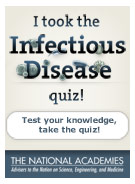
What You Need To Know About Infectious Disease
What do you know about infectious disease?
Which of the following is NOT a vector-borne disease?
-
Correct!
Influenza is not a vector-borne disease, meaning it is not transmitted to humans indirectly via an insect, an arthropod, or another animal. Malaria and yellow fever are transmitted by mosquitoes. Lyme disease is transmitted by deer ticks.
-
Sorry, that’s incorrect.
Influenza is not a vector-borne disease, meaning it is not transmitted to humans indirectly via an insect, an arthropod, or another animal. Malaria and yellow fever are transmitted by mosquitoes. Lyme disease is transmitted by deer ticks.
-
Sorry, that’s incorrect.
Influenza is not a vector-borne disease, meaning it is not transmitted to humans indirectly via an insect, an arthropod, or another animal. Malaria and yellow fever are transmitted by mosquitoes. Lyme disease is transmitted by deer ticks.
-
Sorry, that’s incorrect.
Influenza is not a vector-borne disease, meaning it is not transmitted to humans indirectly via an insect, an arthropod, or another animal. Malaria and yellow fever are transmitted by mosquitoes. Lyme disease is transmitted by deer ticks.
Which is the vector (animal that carries the pathogen) for West Nile virus?
-
Sorry, that’s incorrect.
The mosquito is the vector for West Nile virus. The mosquito suffers no ill effects from the virus but transmits it to humans and other warm-blooded creatures (such as crows) when it takes a blood meal.
-
Correct!
The mosquito is the vector for West Nile virus. The mosquito suffers no ill effects from the virus but transmits it to humans and other warm-blooded creatures (such as crows) when it takes a blood meal.
-
Sorry, that’s incorrect.
The mosquito is the vector for West Nile virus. The mosquito suffers no ill effects from the virus but transmits it to humans and other warm-blooded creatures (such as crows) when it takes a blood meal.
-
Sorry, that’s incorrect.
The mosquito is the vector for West Nile virus. The mosquito suffers no ill effects from the virus but transmits it to humans and other warm-blooded creatures (such as crows) when it takes a blood meal.
True or False: Scientists predict that rising average temperatures in some regions will change the transmission dynamics and geographic range of cholera, malaria, dengue fever, and tick-borne diseases.
-
Correct!
Scientists predict that rising average temperatures in some regions—a result of climate change—will change the transmission dynamics and geographic range of cholera, malaria, dengue fever, and tick-borne diseases.
-
Sorry, that’s incorrect.
Scientists predict that rising average temperatures in some regions—a result of climate change—will change the transmission dynamics and geographic range of cholera, malaria, dengue fever, and tick-borne diseases.
Which of the following is a bacterial infection?
-
Sorry, that’s incorrect.
Strep throat is a bacterial infection. Hookworm is caused by a parasite and chickenpox and influenza are both caused by viruses.
-
Sorry, that’s incorrect.
Strep throat is a bacterial infection. Hookworm is caused by a parasite and chickenpox and influenza are both caused by viruses.
-
Correct!
Strep throat is a bacterial infection. Hookworm is caused by a parasite and chickenpox and influenza are both caused by viruses.
-
Sorry, that’s incorrect.
Strep throat is a bacterial infection. Hookworm is caused by a parasite and chickenpox and influenza are both caused by viruses.
True or False: Antibiotics work by introducing an agent that resembles a disease-causing microbe, thus stimulating the body's immune system to recognize it as foreign, destroy it, and "remember" it, so that it can more easily identify and destroy any similar, disease-causing microbes that it later encounters.
-
Sorry, that’s incorrect.
The above describes how vaccines work. Antibiotics work by either killing bacteria or stopping them from reproducing, allowing the body's natural defenses to eliminate the pathogens.
-
Correct!
The above describes how vaccines work. Antibiotics work by either killing bacteria or stopping them from reproducing, allowing the body's natural defenses to eliminate the pathogens.
Of the more than 1,700 known viruses, bacteria, and other pathogens that infect people, how many have come from animals?
-
Sorry, that’s incorrect.
More than half of the known pathogens that infect people have come from animals. Of the 37 new infectious diseases identified in just the past 30 years, two-thirds sprang from animals.
-
Sorry, that’s incorrect.
More than half of the known pathogens that infect people have come from animals. Of the 37 new infectious diseases identified in just the past 30 years, two-thirds sprang from animals.
-
Correct!
More than half of the known pathogens that infect people have come from animals. Of the 37 new infectious diseases identified in just the past 30 years, two-thirds sprang from animals.
About what percentage of the antibiotics produced in the United States is added to animal feeds to promote growth?
-
Sorry, that’s incorrect.
Almost 70% of all the antibiotics produced in the United States is added to animal feeds—not to fend off disease but to boost growth. These non-therapeutic uses of antibiotics are a perfect way to cultivate microbes that are resistant to antibiotics.
-
Sorry, that’s incorrect.
Almost 70% of all the antibiotics produced in the United States is added to animal feeds—not to fend off disease but to boost growth. These non-therapeutic uses of antibiotics are a perfect way to cultivate microbes that are resistant to antibiotics.
-
Correct!
Almost 70% of all the antibiotics produced in the United States is added to animal feeds—not to fend off disease but to boost growth. These non-therapeutic uses of antibiotics are a perfect way to cultivate microbes that are resistant to antibiotics.
Which deadly pathogen cannot be found naturally in the wild:
-
Sorry, that’s incorrect.
Smallpox cannot be found naturally in the wild. Smallpox was officially declared eradicated from the globe in 1980, after an 11-year WHO vaccination campaign—the first human disease to be eliminated as a naturally spread contagion. Today, the virus remains only in laboratory stockpiles.
-
Sorry, that’s incorrect.
Smallpox cannot be found naturally in the wild. Smallpox was officially declared eradicated from the globe in 1980, after an 11-year WHO vaccination campaign—the first human disease to be eliminated as a naturally spread contagion. Today, the virus remains only in laboratory stockpiles.
-
Correct!
Smallpox cannot be found naturally in the wild. Smallpox was officially declared eradicated from the globe in 1980, after an 11-year WHO vaccination campaign—the first human disease to be eliminated as a naturally spread contagion. Today, the virus remains only in laboratory stockpiles.
Which of the following is NOT a type of infectious agent?
-
Sorry, that’s incorrect.
White blood cells are not a type of infectious agent. Part of the immune system, white blood cells fight infection rather than cause it.
-
Sorry, that’s incorrect.
White blood cells are not a type of infectious agent. Part of the immune system, white blood cells fight infection rather than cause it.
-
Correct!
White blood cells are not a type of infectious agent. Part of the immune system, white blood cells fight infection rather than cause it.
-
Sorry, that’s incorrect.
White blood cells are not a type of infectious agent. Part of the immune system, white blood cells fight infection rather than cause it.
Thank you for taking our quiz.
Place this badge on your Facebook page to show your friends what you know about infectious disease.
Place this badge on your Facebook page to show your friends what you know about infectious disease.
OR, get a higher score to unlock a different badge.
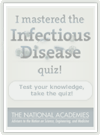
Place this badge on your Facebook page to show your friends what you know about infectious disease.
OR, get a higher score to unlock a different badge.
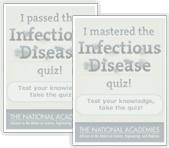
Explore Other Topics
Disease Watchlist
Infectious Disease Defined
- Tissue Culture
The process by which tissues are intentionally grown under controlled conditions.
